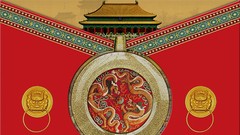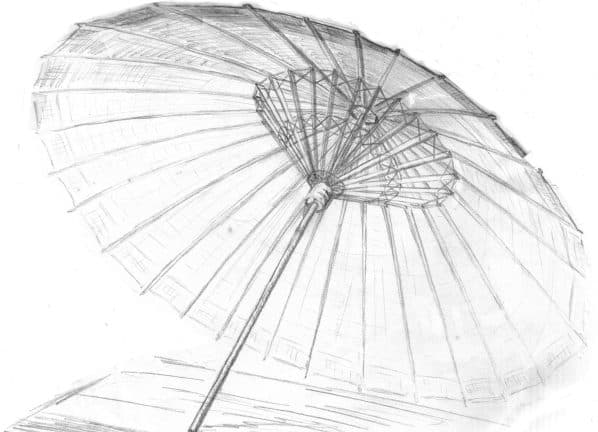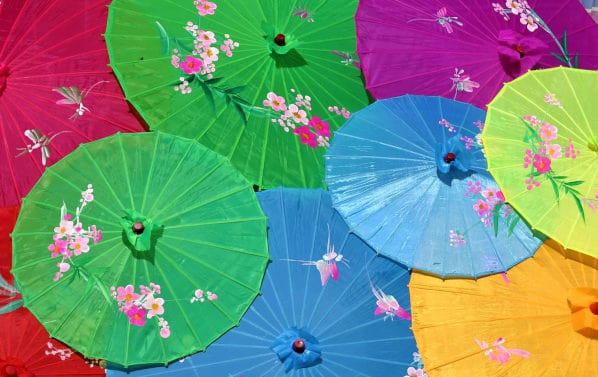
The traditional paper umbrella is one of China’s original inventions, believed to have existed in China since the early 1st century CE.
The paper umbrella has since spread across several different countries in Asia—most notably Japan, but also other South and Southeast Asian countries like Korea, Malaysia, and even India—. However, the paper umbrella remains one of the most important and recognizable aspects of Chinese history and tradition.
The History of Chinese Umbrella
While China is not the home of the umbrella as the ancient invention—the honor belongs to Ancient Egypt over 3,500 years ago—, China is still one of the earliest sources. Umbrellas were initially created from leaves, such as eucalyptus’ or palm trees’, but the Chinese were most likely the first to develop umbrellas from silk and especially oil paper around 2,000 years back.
According to various Chinese historians, the beginnings of the Chinese umbrella involve the smaller parasols, which back then were used not only as a protective measure from rain and the sun’s heat but also as a symbol of prestige and power.
That is, the bigger the umbrella, and the more people needed to carry it, the more powerful the person under the umbrella is. For instance, it is said that 24 people walked in front of an ancient Chinese emperor to carry a parasol.
The earliest paper and silk umbrellas were already carefully crafted with light bamboo or mulberry tree frames, typically weighing only a few hundred grams. However, they can effectively protect against the torrent rain because of the complex process of treating the paper—or silk— with wax or lacquer.
Later on, wax and lacquer were replaced with the more affordable oil, and thus we have the oil-paper umbrellas that are still widely available today.
Click here to see some awesome Chinese Umbrellas.– Opens in new tab.
The First Collapsible Umbrella
According to Historical accounts, the silk umbrella was invented during the times of the Cao-Wei dynasty (206 BCE-220 CE), around 1,700 years ago. The paper umbrella, on the other hand, only appeared way later— during the 1st century BC—, and quickly grew in popularity among the wealthy, mainly as a fashion accessory for the rich women.
The earliest recorded reference of the Chinese umbrella, however, comes from 21CE within the recorded stories of Emperor Wang Mang. It is said that the paper umbrellas were made as decorations for the 4-wheeled chariot of the emperor.
Also, according to written annals of Fu Qian—a high-ranking officer of the Three Kingdoms era (220-280CE) —, Emperor Wang Mang had paper umbrellas that can extend and retract due to the articulated joints. A collapsible umbrella was excavated from the tomb of Wang Guan—the son of Emperor Wang Mang—.
More recent findings, however, suggested that the Chinese collapsible umbrellas possibly existed well before the time of Wang Mang. A possible “fossils” of collapsible umbrellas were found in Luoyang, of which the carbon dating suggested to be as old as 6th century BCE.
Online Courses about Chinese Culture from Udemy (Aff.link)

The Terracotta Army: Accurate Portrayal of Traditional Chinese Umbrella
One of the clearest and interesting depictions of how umbrellas are used in ancient china is with the Terracotta Army from the mausoleum of Emperor Qin Shi Huang (circa 210 BCE), which we can still view in Lintong District, Xi’an.
Emperor Qin Shi Huang ordered the creation of thousands of terracotta statues—which later on dubbed the Terracotta Army— to accompany him in his tomb later on. One of the designs for the statues is of elaborate bronze chariots, of which umbrellas are properly attached to their side.
Since the umbrella is also a “statue”, it is unclear whether paper or silk is used in the construction, and whether the original design is collapsible. However, it is clear evidence that the traditional Chinese umbrella design we used today have been around at least in the time of Emperor Qin Shi Huang.
Check out our “Free Culture Library“. We have compiled some great free resources, about Chinese culture, for your research.

Construction of Chinese Traditional Umbrellas
Making a Chinese paper umbrella involves the creation of five different elements: the paper/silk shade, the head, the ribs, the handle, and the additional artistic ornamentations. If it’s a collapsible umbrella, then a 6th part will be involved: articulation mechanism.
In the making of these 5 or 6 elements, more than 80 different work processes can be involved from start to finish:
Constructing the Shade
There are two different types of shade materials: paper or silk.
Silk umbrellas are expensive and widely regarded as a luxurious item. However, it’s also the most difficult to construct and will require special maintenance.
Paper umbrellas, on the other hand, are easier to construct, and obviously paper is significantly cheaper than silk. Nowadays, the paper material is usually treated with oil to make them water-resistant. China wood oil or tung oil, found throughout central Asia, is commonly used in this process this process
Nowadays, Fujian and Hunan provinces are known as the main producers of Chinese paper umbrellas.
The paper shade is constructed using a special, tear-resistant paper that is also very thin (but also very durable). This paper material is bathed in tung oil, creating a translucent surface and giving the material its water-resistance effect. After it’s dry, the paper shade is properly decorated as desired.
Ribs Construction
The most common material to construct the ribs is bamboo, although other types of wood like the mulberry tree’s barks can also fit.
Bamboo is the most common choice for two main reasons: it’s quite affordable, and bamboo has a unique characteristic of being flexible while also very strong. Typically, the bamboo must be at least 5 years old to ensure sufficient development of resin—which enhances the strength and flexibility—.
Decoration of Chinese Umbrella
The Chinese paper umbrella can incorporate various decorations from simple, solid colors—most commonly red and yellow, but other colors like pink, white, or light blue are also common— to simple drawings of flowers and animals to really complex landscape drawings and intricate patterns.
The artistic decoration is also an important aspect of the traditional Chinese paper umbrella, so proper preparation and care of the paper/silk material to accommodate the painting are very important.
Oil treatment of the paper material is not only important in producing water resistance but also to protect the decorations so it can last longer and resist both wind and rain.
Click here to see some awesome Chinese Umbrellas.– Opens in new tab.

Umbrella In Chinese Wedding
An umbrella is considered as one of the most important elements for a Chinese traditional wedding. The umbrella can be traditional (oil paper or silk) or modern, but it has to be colored bright red.
The red umbrella will be an important part of the bride’s dowry—which is prepared by the bride’s family—.
The dowry, 妝 [gaa jòng], along with the wedding gifts from the groom’s family, is typically given two or three months before the actual wedding day, but the red umbrella is left in the bride’s home to be used in the wedding day.
Typically, during the wedding day, the father of the bride—or can be replaced by a bridesmaid—, holds an umbrella over the head as a symbol of protection from evil spirits. This is done as the bride comes out of the room (after all the rituals and “tests” performed by the groom) and proceeds to the bridal car. Rice is often thrown over the umbrella and the car to wish for good fortune.

Fun Facts About Chinese Umbrella
- An interesting fact is that the Chinese character for the umbrella is very similar to a folding umbrella: 伞 (san).
- Folk dancing with the paper/silk umbrella as the main property has been really popular during the times of the Han Dynasty (206 BCE–220 CE), nowadays, however, it’s more popular in Japan and in countries in Southeast Asia. Umbrella is still often used as a dancing property in China, but not as a traditional folk dance.
- It’s a very common superstition in China that opening umbrellas indoors can bring bad luck—and can even invite evil spirits—.
- Today, the majority of modern umbrellas—like so many other things— are made in China. One city in China, Shangyu District has over a thousand umbrella factories today.
- As mentioned above, although China is not the first inventor of the umbrella, it’s widely credited as the inventor of the first water-resistant umbrella. Umbrellas were originally built to protect people from the heat of the sun (they didn’t really care about UV rays back then), it was the Chinese invention that allows the umbrella to be used in rainy days, just as we know today.
- It is said that some of the earliest Chinese umbrellas were made of 100% leather, and are extremely expensive. As a result, only the nobility and the really rich merchant can afford them as a fashion item and symbol of power.
- Giving umbrellas as gifts in China and Chinese cultures (Read our article “15 Chinese Gift-giving Superstitions“) is a big no since it’s often associated with bad luck and breaking up relationships. The word for umbrella, 伞 sǎn has a similar sound with “breaking up”, sàn.
End Words
The paper umbrella is probably one of the most recognizable remains of the Chinese ancient tradition. See a paper umbrella on the street, and you’ll immediately associate it with China—and probably Japan—.
The water-resistant and waterproof umbrella is also a very important Chinese contribution to the world, giving us a way to protect ourselves from rain as we know today.
Today, the Chinese paper umbrella is still an important part of the Chinese culture and is widely regarded as valuable work of art due to the various (mainly hand-painted) decorations.
Stay in Touch
 Join our newsletter by using the forms on this website or click here!
Join our newsletter by using the forms on this website or click here! Follow us on Google News
Follow us on Google News Follow us on Facebook
Follow us on Facebook
Featured Image by Sasin Tipchai from Pixabay




